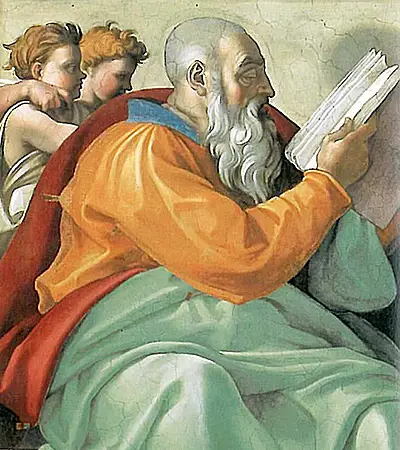This piece is dated at around 1509 and each of the twelve related artworks are around four metres in width and height. Michelangelo would have to tailor his designs to fit the layout of the Chapel, and consider how each series of work would be arranged in relation to each other. His prophets may have been very much supporting elements to other highlights such as The Last Judgement and his Creation of Adam, but there is still great historical and artistic significance to them in any case. Each of these prophet artworks, as with the sibyls, are kept relatively simple, enabling the artist to complete some of them within just a few days and without any aid from his assistants. Michelangelo was being careful to balance aesthetic beauty within each and every item, whilst avoiding making the overall display too busy, and so these more restrained artworks could help to balance the overall design found within the chapel.
Zacharias, or Zechariah, is pictured within this portrait as an elderly man. Artists will often mix around with the ages of their subjects in order to deliver a variety of messaging within each interpretation. Normally, in terms of scripture, he would normally be portrayed as a young man, making this very much a conscious decision by the artist to diverge from the norm. Here he is pictured in a bright green outfit and long curly beard which helps to underline the impact of age. Two young children perch besides him, eager to learn from this wise man. The figure was known to have encouraged the re-construction of a temple and perhaps his inclusion within this series of paintings was a comment by Michelangelo on some architectural projects of his own period, such as perhaps Saint Peter's. This was a Renaissance Man, after all, someone who became heavily involved in a variety of different disciplines, including painting, sculpture, architecture and poetry.
Isaiah, Jeremiah, Ezekiel and Daniel were classed as the four major prophets, based on the level of achievements that they obtained, as well as the amount of scripture in which their lives featured. Zechariah was therefore one of the lesser prophets, though clearly important enough for Michelangelo to decide that he warranted inclusion within the Sistine Chapel. That said, in previous centuries Zechariah was actually held in greater regard, particularly within the Middle Ages. Zechariah is believed to have foretold the Entry into Jerusalem, for example, and at least Michelangelo would choose to place him directly over one of the entrances into the Chapel, which must have been a complement. Despite being in the shadows of other more famous paintings found on display within the same building, there is still plenty of interest in the historical and artistic value of these prophet portraits and they serve an important role in balancing the overall display.


